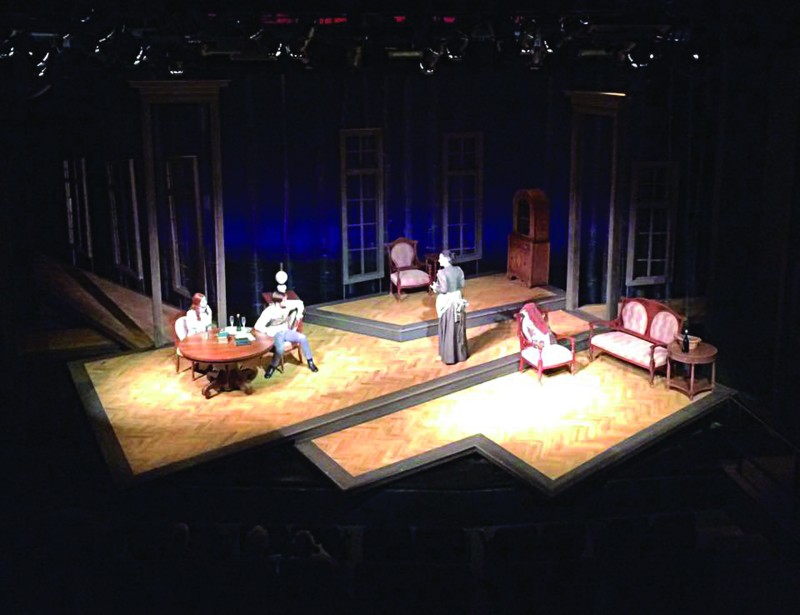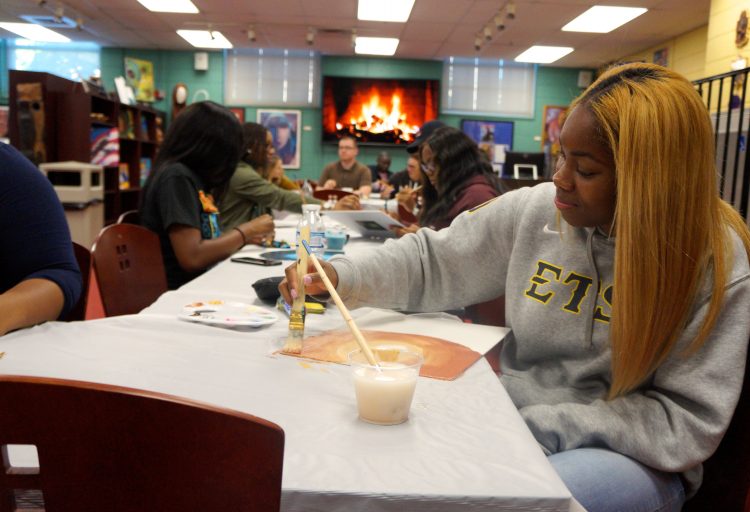APSU students heard the voice of a disgruntled Frida Kahlo call out for estranged spouse Diego Rivera in the Clement Auditorium on Thursday, March 26.
Soon after, students viewed a representation of anguished Salvadoran peasant Rufina Amaya recount the tale of a village massacre and watched as Argentine poet and journalist Alfonsina Storni decided to let the sea overcome her misfortune, ending her life.
The lives of these three women in Latin America’s history were interpreted in “Tres Vidas,” a play put on by the Core Ensemble, a travelling group that performs “a series of chamber music theatre works combining music with other performance elements, such as narrative and dance,” according to the group’s website. The event was co-sponsored by the Hispanic Cultural Center, Student Life and Engagement, the Department of History and Philosophy and the Department of Language and Literature.
The work was divided into three acts, each depicting the life of each woman.
The sets were minimal, leaving no distractions for full ability to soak in each word spoken and sung by lead actress Denise Estrada and hear the range of music played by pianist David Berry.
“We do this show in another form with percussion, cello and piano,” Berry said. “Somehow, you have to figure out, when it’s just her and me how to evoke some of these sounds. It’s always a challenge,” Berry said.
The creators of “Tres Vidas” had to consider how to properly represent the different cultures of Latin America.
“There are two ways the music came about,” Berry said. “Investigating folk music was a big part of it. There was an interest in how you capture new sounds as well. We use new music to have things that pop and use echoes you don’t find in folk music. We bring together the old and new [to find] what best illustrates and compliments the dramatic art of each of the historical figures’ lives.”
The search for inspiring Latin American women worthy of representation is no struggle, though.
“I took on these roles, and it was so much to carry with me every day,” Estrada said. “Not only the lines, but looking into these women, researching them [to] find out about these heavy parts of their lives they lived with and died with.”
“Tres Vidas” covers three areas of Latin America: Mexico in North America, El Salvador in Central America and Argentina in South America.
Frida Kahlo, a famous Mexican artist known for self-portraits and a rebellious attitude, was an obvious choice for the creators and performers.
“Tres Vidas’” representation of Kahlo portrayed this attitude. In the first act, Kahlo straddled a backwards facing chair, smoked a cigar and downed several shots of tequila. “I drink to drown my sorrows, but the damn things have learned to swim,” Kahlo’s character said.
“She was a remarkably fiery individual and a modern-day power couple with Diego Rivera,” Estrada said in justification of choosing Kahlo to be one of the three memorialized in “Tres Vidas.”
Rufina Amaya was a lesser-known figure, and the show’s creators used the opportunity to educate the public of her tragic tale of survival.
“She was the sole survivor of this massacre,” Estrada said. “The Salvadoran government said, ‘This never happened. She’s lying.’”
Amaya’s scene didn’t feature any songs with lyrics. The piano was used to create a dark, ominous feeling.
Amaya’s character described herself as a “woman without a name” and used her voice to express the anguish felt after losing the entire town to guerrilla warfare.
“Typically, the feedback we get when we go to colleges after the show was that people say, ‘Oh, I immediately went and Googled [Rufina Amaya],’’’ Estrada said.
The last act was dedicated to Alfonsina Storni and romanticized her suicide.
“The beginning of her story opens up with this beautiful song ‘Alfonsina y el Mar,”’ Estrada said. “It’s this legendary tale, a very romantic spin on her story. In reality, she probably jumped off a pier with rocks in her pockets.”
Storni’s act was the most sophisticated of the three. Estrada wore a 1920s-era sequined evening gown to embody the time in which Storni prospered.
“It is impossible to be a thinking woman and not be a feminist,” Storni’s character said.
Storni not only produced critically recognized poetry, but was also a journalist and women’s rights activist.
“Tres Vidas” cast members aimed to embody the spirit of their characters to give the audience a genuine, historically accurate understanding of their lives. “It’s a beautiful thing to be able to educate and inspire through art,” Estrada said.
To learn more about Core Ensemble and its upcoming productions, visit www.coreensemble.com and like Core Ensemble on Facebook.









